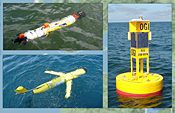You are here
Estuarine Turbidity Maxima Locator Tool
The ability to find the ETM is paramount for the August cruise, and our current capabilities do not provide sufficient help for this task.
I spoke with Joseph and Charles today and came up with possible solutions in increasing order of complexity.
Simplest solution: Manual transects across salinity intrusion boundary
Allow user to generate a transect by clicking points on the map. The transect will be colored by salinity and include barbs representing velocities.
Example:
[img_assist|nid=383|title=|desc=|link=popup|align=left|width=200|height=142]
With current capabilities, the user can visually locate the salinity intrusion at a particular time using the isolines plots in the cruise mapper.
Once located, the user can draw a transect across the salinity intrusion boundary and generate a transect plot like the one above. If the barbs indicate that the river velocity and the tidal velocity are opposed and "sufficiently strong," then the users can navigate to the corresponding lat/lon.
ETM Locator
As an extension, the computer can help the useer find the ETM using the following algorithm:
Walk along the the channel from both ends and project the velocity onto the along-channel vector at each step.
If the sign of the velocity changes, stop.
Return the lat, lon and display an along-channel transect plot around the neighboring points.
Advanced ETM Locator
The ETM location algorithm above may return a lot of false positives.
To reduce the number of false positives, we can include the mixing length as a reality check to the sign change. Also, we can filter sign changes that do not last very long or are of low magnitude.
With these extensions, the algorithm will frequently (and correctly) indicate that no ETM-generating event has occurred at the current timestep. However, this does not mean that the ETM is not available for sampling.
Another extension, then, is to search across many recent timesteps for ETM-generating events, then run particle tracking to see where the ETM may have advected.
I propose we sprint to develop the first solution as a "utility benchmark" for more advanced features.






